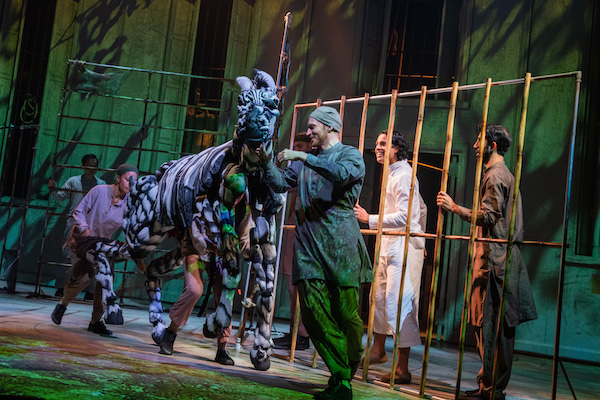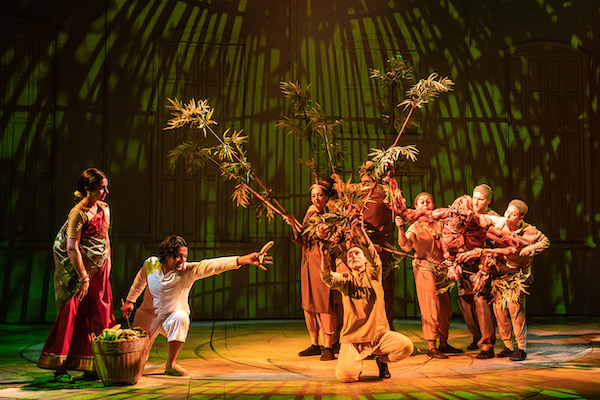Theater Review: “Life of Pi” — An Enchantingly Theatrical Ocean Voyage
By David Greenham
This stunning, brand new production of the UK’s Life of Pi is stopping in Cambridge for a month or so before sailing down to Broadway.
Life of Pi. Based on the novel by Yann Martel. Adapted for the stage by Lolita Chakrabarti. Directed by Max Webster. Scenic and costume design by Tim Hatley. Puppetry and movement direction by Finn Caldwell. Puppet design by Nick Barnes and Finn Caldwell. Video design by Andrzej Goulding, lighting design by Tim Lutkin, and sound design by Carolyn Downing. Original music by Andrew T. Mackay. At the Loeb Drama Center, Cambridge, through January 29, 2023.

Celia Mei Ruben, Nikki Calonge, and Rowan Magee (“Black and White”), Adi Dixit (“Pi”), Sathya Sridharan (“Mamaji”), and the company of Life of Pi. Photo: Matthew Murphy and Evan Zimmerman for MurphyMade.
In the early chapters of Yann Martel’s 2001 novel Life of Pi, the narrator foreshadows that “animals in the wild lead lives of compulsion and necessity within an unforgiving social hierarchy in an environment the supply of fear is high and the supply of food low and where territory must constantly be defended, and parasites forever endured.”
Lolita Chakrabarti’s Olivier-award winning adaptation beautifully captures that compulsion and necessity. Following a successful UK debut, the play has stormed across the sea with a stunning, brand new production that’s stopping in Cambridge for a month or so before sailing down to Broadway, where I predict it will garner its fair share of award attention as well.
Director Max Webster has choreographed a seamless ensemble led by Adi Dixit’s Pi to create the three worlds of Martel’s epic yet intimate story of survival: a barren hospital in Mexico, the lush and colorful Indian town of Pondicherry, and the beautiful and unpredictable open sea.
The production begins in 1978 at a hospital where Pi — Piscine Molitor Patel — has landed, traumatized, following his rescue after 227 days adrift at sea. Pi, his family, and the animals from their zoo had been aboard the Japanese cargo ship Tsimtsum when it sank on its journey from India to Canada. Pi is the only survivor.
Canadian diplomat Lulu Chen (Kirstin Louie) represents Pi’s interests because his family had been heading to Winnipeg when the tragedy struck. Japanese insurance investigator Mr. Okamoto (Daisuke Tsuji) is less interested in Pi’s comfort than in learning the true story of what happened aboard the vessel.

Mahira Kakkar (“Amma”), Adi Dixit (“Pi”), Salma Shaw, Betsy Rosen, Nikki Calonge, Rowan Magee, Celia Mei Rubin (“Orange Juice”), and the company of Life of Pi. Photo: Matthew Murphy and Evan Zimmerman for MurphyMade
Aided by his nurse (wonderfully portrayed by Mahira Kakkar), Pi is willing to share his story on his own terms. And that narrative ignites the explosive magic of Life of Pi.
The location shifts to India years earlier, after Pi’s family had taken over a zoo in the Pondicherry Botanical Gardens. His gruff father (Rajesh Bose) doesn’t believe that Pi or his sister Rani (Sonya Venugopal) take the dangers of the zoo seriously enough. Their mother, Amma (also Mahira Kakkar), and an insightful teacher, Mrs. Biology Kumar (Salma Show), fill the children with ample amounts of love and lessons in humanity. Pi explains to his listeners, “Our life was idyllic.”
But dad knows better. The corrupt government is increasingly becoming a threat to the family and their beloved animals. “This world is dangerous,” Pi’s father warns. “It is a mistake to think we’re safe.” The family and their animals will move to Winnipeg, where, with support from the Canadian government, a new zoo can be created.
The imposing structure and action of the crew of the freighter Tsimtsum is foreboding from the start. Once a storm begins to churn, the danger increases.
But it’s not only the people who are in grave danger. The animals are too. In this imaginative production, which is rooted in puppetry, the animals are in many ways more finely detailed presences than the human actors. Once the storm surges, the animals are knocked free from their crates. The resulting anarchy leads to an image of Pi, alone and adrift in the open sea.
The compelling story of Pi’s survival, enlivened by his observations and hallucinations, along with the frequent twists in the plot and nuggets of wisdom supplied by the ghosts of his family and other characters, ensures that the production, which runs a little over two hours with an intermission, zips along.

Adi Dixit (“Pi”), Rowan Magee, Celia Mei Rubin, and Nikki Calonge (“Richard Parker”)
The performances and Max Webster’s direction are strong across the board, but that’s not what makes this production memorable. It’s the visual spectacle, the physical grace of the animals, as maneuvered by an ensemble of puppeteers, as well as the brilliant use of projections, lighting, and sound.
The spectacular marionettes, designed by Nick Barnes and Finn Caldwell, are a remarkable step forward in sophisticated design craft, going beyond the heralded animals in The Lion King, or even Joey, the puppet star of The National Theatre’s War Horse. The stylized critters in Life of Pi assert themselves, viscerally, as living (and dying) beings. The movements, sounds, and rhythms of the puppets are realism accented by fantasy. The birds, fish, and giant sea turtles float and flutter with grace. Operated by two and sometimes three puppeteers, the zebras, an orangutan, a goat, a hyena, and even a giraffe move exquisitely through Pi’s adventure. The co-star of Life of Pi is the notorious Bengal Tiger, Richard Parker (voiced by Brian Thomas Abraham). He’s terrifying, threatening, imposing, majestic, and lovable in all the right ways.
Tim Hatley’s set and costumes are both surprising and completely functional. On press night there appeared to still be some challenges with the turntable — aren’t there always difficulties with the turntable? But the splendidly chameleonic flexibility of the set makes it a major character in the story. Much of the play centers on Pi as he is adrift at sea or in the Mexican hospital, but the set also delivers, with aplomb, the beauty and color of the Indian scenes at the zoo and later a visit to a market. Andrew T. Mackay’s original score buoys the production’s many ups and downs.
But it’s really the video design by Andrzej Goulding, lighting design by Tim Lutkin, and sound design by Carolyn Downing that transform Life of Pi into an unforgettable night of theater. If you’re a frequent theatergoer, you have become acclimated to the dependence of modern stage productions on projections. At best they are tastefully layered onto the set. At worst, they feel like an effort to avoid hiring a scene painter. Goulding has created a marvelously textured videoscape. As the ocean current flows, you feel like you’re moving. The wind seems to blow your hair and when it rains you feel as if you want to look for cover. The projections are so intricately interwoven with the lighting and sound that Pi’s experiences become powerfully concrete as well as emotional.
The book ends with Mr. Okamoto’s report to the insurance company. He writes that Life of Pi is “an outstanding story of courage and endurance in the face of extraordinarily difficult and tragic circumstances,” and concludes, “very few castaways can claim to have survived so long at sea as Mr. Patel, and none in the company of an adult Bengal tiger.” This Life of Pi is so theatrically dazzling it makes the fantastical seem possible.
Mark Favermann looks at Life of Pi‘s design elements.
David Greenham is an adjunct lecturer of Drama at the University of Maine at Augusta, and is the executive director of the Maine Arts Commission. He has been a theater artist and arts administrator in Maine for more than 30 years.
Tagged: Ada Dixit, American Repertory Theater, Life of Pi, Lolita Chakra

I have not seen this production. It is probably as fabulous as David says it is. When it goes to Broadway may it run for years, make heaping bags of money for its backers, and win many awards for all involved.
But this point must be made — and I challenge other theater critics to do so, or argue why it is extraneous. As tourists pay $100+ ticket prices to applaud lifelike puppets on stage, animals are not doing so well in the real world. In fact, a recent headline for a NYTimes column sums up the growing crisis — “Can We Save Nature?” The jury is out — the latest news is that some computer models show that more than a quarter of the world’s biodiversity will be wiped out by the year 2100 as a result of climate and land use changes. “Children born today who live into their 70s can expect to witness the disappearance of literally thousands of plant and animal species, from the tiny orchids and the smallest insects, to iconic animals such as the elephant and the koala … all in one human lifetime,” Professor Corey Bradshaw of Flinders University, one of the authors of the study, says. Perhaps this is alarmist. Maybe the extinction will take a little longer … does it really matter?
So, while we pay to adore ingenious animal puppets or virtual reality zoos, the future for tigers, giraffes, etc, looks bleak unless serious changes are made around the globe. Why should that horrific news trouble the bubble that is Broadway? Why should critics be grouches? Well, the end of nature will mean our end as well. “Without major changes in human society, we stand to lose much of what sustains life on our planet,” says Bradshaw. At the very least, box office will be less dependably — boffo.
Nice review of a great play. But: The puppets are not marionettes, David. Marionettes are manipulated from above by strings. These puppets are manipulated by hand.